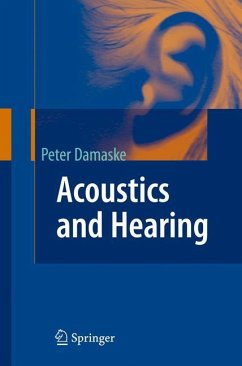When you listen to music at home, you would like to have an acoustic impression close to being in the concert hall. This is achieved by an advanced two-loudspeaker technique and electronic handling of the signals. The way to head-related sound reproduction and reception to get the original impression is explained in this comprehensive book on the outer influence of hearing and how to achieve perfect stereo effects. The book also introduces a theory of drift thresholds.
In a good concert hall, a big orchestra can evoke remarkably spacious sounds. The concertgoer is surrounded by the physical sound waves, and out of these waves the subjective sound impressions are created in the listener's head. This biological "measuring device" organized itself during childhood. With no special effort-and quite continuously-it performs parallel data proce- ing and makes no distinction between complex or simple analysis. Imagine that the orchestra, after complete silence, strikes a load, abrupt chord. In that moment we can watch the immediate response of the hall. The phenomenon is called the onset of reverberation. During this process the l- tener's auditory system has to evaluate the direct sound of each particular - sical instrument along with portions of sound re ected from the walls or the ceiling. If those sound re ections arrive at the listener's ears less than 50 ms later than the direct sound, they are called early re?ections. All these amounts of soundmake up such an intricate mixture that the ear is unable to resolve it as a series of separate events. From a favourable seat in the auditorium the listener receives only one complex impression, which can be wide and yet very detailed and appears abruptly in the front. This subjective impression may brie y be named a sound image. Its width and its depth, its facets and the weights or contrasts of its different parts characterize "the acoustics" of the concert hall and also the orchestra.
Hinweis: Dieser Artikel kann nur an eine deutsche Lieferadresse ausgeliefert werden.
In a good concert hall, a big orchestra can evoke remarkably spacious sounds. The concertgoer is surrounded by the physical sound waves, and out of these waves the subjective sound impressions are created in the listener's head. This biological "measuring device" organized itself during childhood. With no special effort-and quite continuously-it performs parallel data proce- ing and makes no distinction between complex or simple analysis. Imagine that the orchestra, after complete silence, strikes a load, abrupt chord. In that moment we can watch the immediate response of the hall. The phenomenon is called the onset of reverberation. During this process the l- tener's auditory system has to evaluate the direct sound of each particular - sical instrument along with portions of sound re ected from the walls or the ceiling. If those sound re ections arrive at the listener's ears less than 50 ms later than the direct sound, they are called early re?ections. All these amounts of soundmake up such an intricate mixture that the ear is unable to resolve it as a series of separate events. From a favourable seat in the auditorium the listener receives only one complex impression, which can be wide and yet very detailed and appears abruptly in the front. This subjective impression may brie y be named a sound image. Its width and its depth, its facets and the weights or contrasts of its different parts characterize "the acoustics" of the concert hall and also the orchestra.
Hinweis: Dieser Artikel kann nur an eine deutsche Lieferadresse ausgeliefert werden.
Aus den Rezensionen:
"... Beim Verfassen des englischen Textes ... achtete der Autor auf Verständlichkeit, besondere Fachkenntnisse werden beim Lesen nicht vorausgesetzt. ... Wie das Gehör mit derart komplexen Schallvorgängen fertig wird, durch die es eigentlich permanent überfordert ist, beschreibt Damaske in 'Acoustics and Hearing'. Dabei wird von spannenden Experimenten berichtet, die er 1971 in einem schalltoten Raum an der Universität Göttingen durchführte ..." (Goslarsche Zeitung, 15/September/2009, S. 18)
"... Beim Verfassen des englischen Textes ... achtete der Autor auf Verständlichkeit, besondere Fachkenntnisse werden beim Lesen nicht vorausgesetzt. ... Wie das Gehör mit derart komplexen Schallvorgängen fertig wird, durch die es eigentlich permanent überfordert ist, beschreibt Damaske in 'Acoustics and Hearing'. Dabei wird von spannenden Experimenten berichtet, die er 1971 in einem schalltoten Raum an der Universität Göttingen durchführte ..." (Goslarsche Zeitung, 15/September/2009, S. 18)








